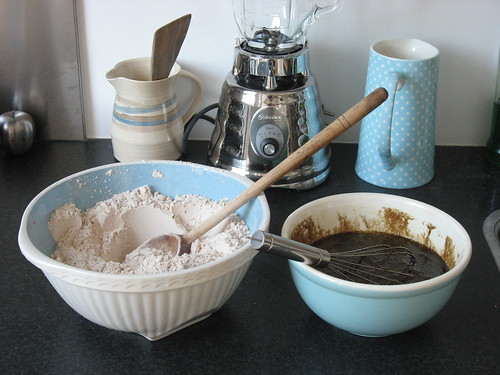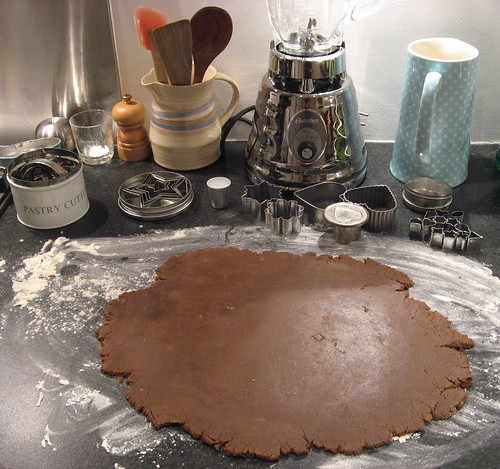
Gingerbread cookies
This recipe was the one my Grandfather used to make and the one my Mom always makes. Now it's become my gingerbread cookie recipe too. I grew up with gingerbread people and lots of different animal shapes. My tradition, when I bake them, is lots stars and hearts and ruffled circles with other tiny shapes cut out. I bought a set of super tiny cutters this year to have even more fun cutting out fancy shapes from the bigger cookies. There's a spice shop in the Albert Cuyp market that has tons of super fresh spices and other kitchen odds and ends. I found a little tin of 12 tiny cookie cutter shapes for just a few euros. Much fancy cookie fun was subsequently had!

Gingerbread batter
Grandfather's Gingerbread Men
(this is the doubled version, you can safely halve this recipe)
5 1/2 c white flour
1 Tbsp baking powder
1/2 tsp salt
2-3 tsp ginger
2-3 tsp cinnamon
1/2 tsp cloves
1 Tbsp unsweetened cocoa powder
1 1/3 c molasses
2/3 c sugar (technically not a "wet" ingredient, but it goes in with them)
1 c butter, melted
2 large eggs
Combine dry ingredients (while melted butter is cooling). Mix wet ingredients thoroughly, including egg at end. Combine all together and mix evenly to moisten.

Gingerbread batter resting
Chill in plastic bag 2 hours or overnight (allow several hours to warm up if in fridge overnight). Roll out and cut. Bake at 375° F for 10-12 minutes (or at 175° C for 8-10 minutes) on a floured (or parchment paper lined) cookie sheet.

Gingerbread dough
That's the basic recipe, but I'll let you in on the tricks I've learned from my Mom over the years.

Gingerbread dough with shapes
Secret tips
- Let the eggs warm up to room temperature by whisking them up in a bowl and leaving to sit out.
- Put the molasses in with the butter and melt slowly in the microwave. The molasses will be much easier to mix this way (but make sure you do it in increments, stirring in between so you don't scorch it). Let it cool a bit before mixing in with the eggs.
- Make sure your flour isn't too densely packed. I estimate that I used about 840-860g. You can try leaving out half a cup until you see if it's coming together. If you add too much flour, it will be annoyingly crumbly and hard to pack into a ball or roll out.
- Possibly the most important trick: don't chill the dough in the fridge unless you're not making the cookies until the next day. If it's too cold when you try to roll it out, it will go all crumbly and hard to work with. I just leave it to rest in a bag on the counter for a few hours.
- Unless you have lots of counter space, only try to roll out half the dough at a time. Put the other half in the bag somewhere cooler since the dough will start to get really warm and too soft to handle once the oven is running.
- These gingerbread cookies have the perfect blend of softness and crispiness. This does mean you shouldn't try to make a gingerbread house with them, which requires a completely crisp cookie.
 Gingerbread cookies cooling
Gingerbread cookies cooling
4 comments:
argh! I found this recipe turned out way too dry and nothing would stick together. After talking to mom I found out she reserves at least a half cup of flour to use for powdering the board when you roll out the dough! You're not supposed to put it all in. Is that what you do??
I put in all the flour and had no problem with mixing it all together.... this year. But I know in previous years I've had a hard time getting it to all stick together. (Usually I'd end up mushing it into a ball in the bag).
This is the first year I microwaved the molasses in with the butter though, so that might be part of it. I think my flour was lighter and less densely packed too. Since I buy it in 1kg bags here, it's "fluffier" when I scoop it out, meaning probably less actual flour goes in (here's where weight measurements would be useful!).
Definitely worth remembering to reserve 1/2 cup of the flour until you see how it's behaving.
Si I tried it again last night - and had the opposite problem! Too soft and sticky! I kneaded in a lot of extra flour as I went along. I think it probably is a sifting issue as you said. I fluffed it up a lot before measuring it out. I had the same problem with the shortbread only worse, then had to guess how much to add extra - came out too floury and bland, bla. Going to correct that with icing.
I found that once it was rolled out and the kitchen was all cozy with the oven running, it gets very soft. So I put half in the fridge while I make the first batch. It's not in there long enough to make it too cold and hard, just enough to stop it being so melty!
The same thing can happen with shortbread if it warms up too much. All that butter starts to melt and make it too sticky. The solution is a brief visit to the fridge, rather than more flour. Maybe when I do my shortbread I'll try weighing my flour to see how much I actually use this time.
Post a Comment